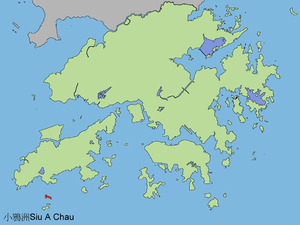
Siu A Chau
Siu A Chau (Chinese: 小鴉洲) is an uninhabited island of Hong Kong, part of the Soko Islands group, located south of Lantau Island.
Geography
Siu A Chau is the northernmost and the second largest of the Soko Islands, after Tai A Chau. It is dumbbell-shaped and has a rugged indented coastline with steep slopes. The highest point of the island is at 74 meters. There is a small beach at the northernmost point of the island.
History
In 1937, Walter Schofield, then a Cadet Officer in the Hong Kong Civil Service, wrote that Siu A Chau was "another settlement of early man" and that it had a "fishing village of huts very different from ordinary Chinese dwellings" at the time of writing.
Features
There is a temple on the south side of the island.
A low-level radioactive waste (LLRW) facility began operation at Siu A Chau in July 2005. Low-level radioactive wastes which had previously been stored in disused tunnels, two factories and five hospitals were subsequently transferred to the Siu A Chau facility. Part of this waste was relocated from the disused Mount Parish air-raid tunnels at Queen's Road East, in Wan Chai. The 55 m3 of LLRW stored there had raised objections. The opening ceremony of the facility was held in June 2006.

A Chau
For A Chau (丫洲) in Tai Po District, see Centre Island, Hong Kong.
A Chau (Chinese: 鴉洲, Jyutping: aa1 zau1, Pinyin: Yāzhōu) is a small island in the inner most of Starling Inlet (Sha Tau Kok Hoi), off Nam Chung, in the north-eastern New Territories of Hong Kong. It is under the administration of North District. The island falls within the Closed Area.
Fauna
A Chau has been designated as a Site of Special Scientific Interest since 1985. The fauna of the island includes night heron, little egret, great egret, black-headed gull and herring gull. It is also a breeding site for the passage migrants. It was reported in 2007 that A Chau was the largest egretry in Hong Kong and may also have been one of the most important night roosting sites for the ardeids in winter.
See also
References
Podcasts:

